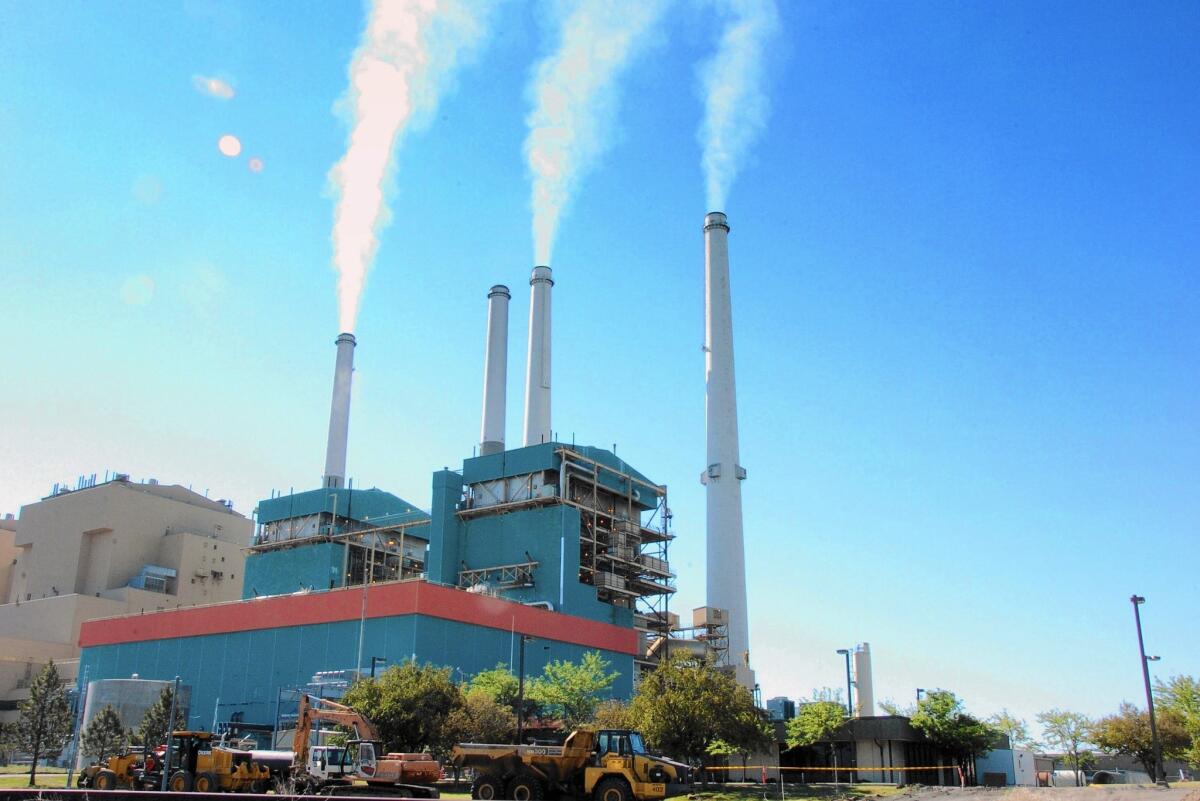Supreme Court blocks EPA’s air pollution rules for power plants

The Supreme Court said the Environmental Protection Agency needs to weigh the economic impact of proposed regulations on power companies and their customers.
- Share via
Reporting from washington — The Supreme Court dealt a blow to the Obama administration’s environmental plans, deciding that efforts to sharply limit hazardous power plant emissions must also consider their costs.
In a 5-4 decision Monday, the justices said the Environmental Protection Agency needs to weigh the economic impact of proposed regulations — estimated at $9.6 billion annually — on power companies and their customers.
The decision marks a victory for the coal and power industries as well as a coalition of Republican-led states that had sued to block the new rules.
The National Assn. of Manufacturers welcomed the decision, saying aggressive regulations place American companies at a disadvantage. “We need a balanced approach to regulations that considers both costs and benefits,” said Linda Kelly, its general counsel.
Environmentalists were disappointed but described the ruling as more of a delay than a defeat.
“The court has sided with the Dirty Delinquents — the small percentage of coal-fired plants that haven’t cleaned up — and against the majority that are already protecting our children from mercury and other toxic pollutants,” said Fred Krupp, president of the Environmental Defense Fund.
The “mercury and air toxins” rule has been 25 years in the making. Congress in 1990 strengthened the Clean Air Act and told the EPA to identify the major sources for more than 180 hazardous air pollutants, including mercury and arsenic. The agency identified coal- and oil-fired plants, setting the stage for tougher regulations.
The rules took far longer than lawmakers had anticipated. The Clinton administration completed the study and prepared the rules, but they were blocked during the George W. Bush administration. Under President Obama, the EPA issued proposed regulations in 2012 that were to take full effect this summer.
A U.S. appeals court upheld the rules last year, but to the surprise of environmentalists, the Supreme Court agreed to hear the industry’s appeal. The high court’s intervention came just as many in Washington, including congressional Republicans, were complaining that President Obama and his administration were exceeding their legal authority.
Justice Antonin Scalia said the regulations were not reasonable because the EPA had not weighed costs from the beginning. The agency focused on the impact to the public’s health and “considered cost irrelevant,” he said. Chief Justice John G. Roberts Jr. and Justices Anthony M. Kennedy, Clarence Thomas and Samuel A. Alito Jr. agreed in Michigan vs. EPA.
In dissent, Justice Elena Kagan accused the majority of “micromanagement of EPA’s rule-making.” The law spoke only of “appropriate” regulations, she said.
It is not entirely clear what the EPA will do now. The government’s lawyers told the court that the public benefits of cleaner air would be more than $37 billion, far exceeding the cost.
The agency has said the new rules would save as many as 11,000 lives per year. Mercury is highly toxic in the air and the water, and it builds up through the food chain. It is particularly dangerous for a pregnant woman and her developing baby. Other toxic pollutants are believed to trigger asthma attacks.
The decision “overturns one of EPA’s most important pollution control rules,” said Harvard law professor Richard Lazarus, an expert on environmental law. “The good news is that EPA can likely go back and reissue the same rule, this time taking costs into account. The bad news is that this may take a long time to accomplish. The Obama administration will be hard-pressed to get the job done before it goes out of office.”
The decision could also affect Obama’s plans to combat climate change, which include rules that would require a 30% reduction in carbon pollution by 2030.
White House Press Secretary Josh Earnest said the administration was disappointed with Monday’s Supreme Court decision, but said it should not get in the way of other plans. “These are two separate rule-making processes,” he said.
Sen. Barbara Boxer (D-Calif.), who sits on the Senate’s Environment and Public Works Committee, said the court decision does not question the ability of the EPA to regulate pollution. She urged the agency to move quickly to incorporate a cost analysis of the proposed regulations.
The Supreme Court’s decision, however, “doesn’t really matter in California,” said Jan Smutny-Jones, chief executive of the Independent Energy Producers Assn. in Sacramento. That’s because they state has moved quickly to wean itself off of locally produced fossil fuels.
Five years ago, California derived about 16% of its power from coal, with a “very small amount” produced within the state by minor producers, Smutny-Jones said. “Those have all gone away or are in the process of going away, having converted to biomass or shutting down,” he said. “Whatever generation in-state there was is effectively gone.”
Most utilities in California have committed to abandoning coal from out-of-state sources as well. Others — such as the Los Angeles Department of Water and Power and smaller utilities covering Anaheim, Riverside, Pasadena, Burbank and Glendale — are “negotiating an exit strategy” from out-of-state importers, according to the Sierra Club.
“It is very promising that California will be truly coal-free by 2025,” said Marta Stoepker, a spokeswoman for the Sierra Club’s Southwest Region.
Nationwide, only a few dozen coal plants continue to operate without plans to install pollution controls for mercury and air toxins, Mary Anne Hitt, director of the Sierra Club’s Beyond Coal Campaign, said in a statement.
“Practically speaking, today’s decision won’t revive the fortunes of Big Coal or slow down our nation’s transition to clean energy,” she said. “However, this flawed decision does raise concerns for our children and pregnant women, as utilities may further delay compliance decisions, or use this as an excuse to refuse to run their pollution controls.”
Times staff writers Tiffany Hsu in Los Angeles and Christi Parsons in Washington contributed to this report.
More to Read
Inside the business of entertainment
The Wide Shot brings you news, analysis and insights on everything from streaming wars to production — and what it all means for the future.
You may occasionally receive promotional content from the Los Angeles Times.











